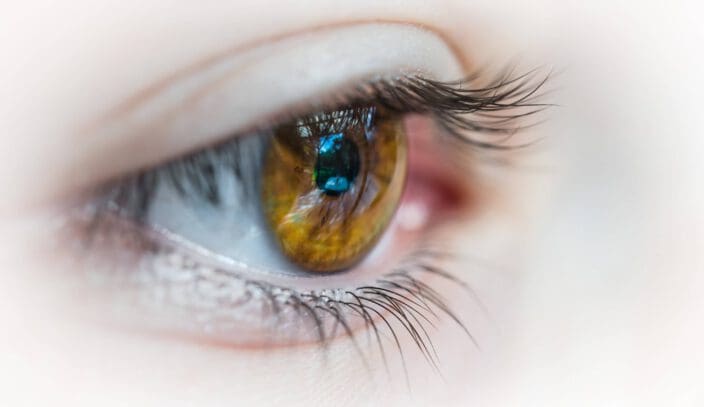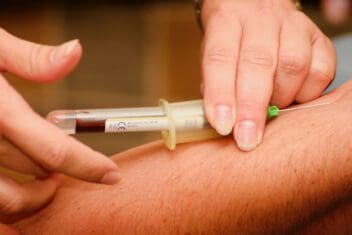The Connection Between Cholesterol & Your Eyes
Home / Vision Education Center /
Last Updated:
Cholesterol is a waxy substance that your body uses in its normal functioning, but different types of cholesterol can be good or bad for you. The causes of high cholesterol can range from your genetic makeup to your lifestyle or medical conditions
Table of Contents
High levels of cholesterol may affect your eyes and may lead to blockages in your retina. High cholesterol may be a risk factor for the development of one type of glaucoma.
Your retina may be the only area of your body that physicians can use to observe clots in your veins and arteries due to high cholesterol. If you have high cholesterol levels, discuss the situation with your physician and use medication if applicable.
In addition to the use of medications, you can also adjust your diet and begin exercising to control your cholesterol levels if you are approved to do so by your physician.

What Is Cholesterol?
The waxy substance that we refer to as cholesterol is manufactured by your body. It is important in different functions in your body, such as producing hormones and synthesizing vitamins. It is carried through your bloodstream in the form of lipoproteins, which are waxy/fatty materials covered by a protein shell.
There are two types of lipoproteins (cholesterol) that are found in your body.
You deserve clear vision. We can help.
With 135+ locations and over 2.5 million procedures performed, our board-certified eye surgeons deliver results you can trust. Your journey to better vision starts here.
- High-density lipoproteins (HDL) are considered to be the beneficial form of cholesterol that your body manufactures.
- Low-density lipoproteins (LDL) are considered to be the detrimental forms of cholesterol that are commonly absorbed from certain foods.
- Triglycerides are also manufactured by your body from the food you consume. Triglycerides are considered to be healthy at low levels, but in high levels, they represent a potential health risk, especially when paired with high LDL.
Reasons for High Cholesterol
When health professionals refer to high cholesterol levels, they are typically referring to high levels of LDL or triglycerides. The causes of high cholesterol include:
- Genetic makeup, which is inherited from your parents.
- Diet, which can lead to elevated cholesterol levels as a result of eating high-sugar foods or beverages, high-fat foods, or processed foods.
- Medical conditions, such as diabetes or a thyroid disorder.
- Insufficient activity or exercise.
- Use of certain medications, drugs, tobacco products, or alcohol.
- Metabolic changes, including the slowing of metabolism due to age.
- Weight, with obesity being a major risk factor for high cholesterol.

High Cholesterol & Retinal Artery Occlusions
HDL carries cholesterol from the walls of your arteries to your liver, whereas LDL transports cholesterol to the tissues in your body and the walls of your arteries. Thus, high levels of LDL can lead to narrowing of the veins and arteries, plaque buildup in the walls of veins and arteries, and the development of clots as a result of plaque buildup in an artery or as a result of plaque breaking off and moving to a more narrow artery.
A stroke occurs due to decreased blood flow in the brain. This results from narrowing arteries or arterial blockages. A heart attack can occur as a result of blockages in the heart. When blockages occur in the retina of the eyes, they are known as retinal arterial occlusions.
Signs of Retinal Artery Occlusions
If retinal arterial occlusions have occurred, these signs may be present:
- A bluish-colored ring forming around the outside of the cornea (known as arcus senillis), which represents deposits of cholesterol
- Xanthelasma, small yellow-like elevations of the skin above the eyes or near the nose that may also signal high cholesterol levels
- A Hollenhorst plaque, a buildup of cholesterol that has broken off a clot from another artery, such as the carotid artery
While having either an arcus senillis or xanthelasma would most likely be considered benign or harmless, a Hollenhorst plaque can block blood flow and result in death of the tissue that is being fed by the artery. This can lead to vision loss that could be permanent. These plaques may also signal an increased potential for stroke.
Glaucoma
A recent study published in the Journal of the American Medical Association: Ophthalmology reviewed over 800 cases of primary open-angle glaucoma, which is the most common type of glaucoma. These cases were part of a larger sample of over 136,000 participants.
The study participants were followed for 15 years or longer. The findings indicated that for every 20-point increase in a person’s total cholesterol level, there was a 7 percent increase in the risk of developing glaucoma. Using cholesterol-lowering medications appeared to decrease the risk.
You deserve clear vision. We can help.
With 135+ locations and over 2.5 million procedures performed, our board-certified eye surgeons deliver results you can trust. Your journey to better vision starts here.
Diagnosing the Effects of High Cholesterol

Your eyes are the only areas of your body where your blood vessels can be observed without actually cutting into your bodily tissues.
An examination of the blood vessels in your eyes can help physicians determine the potential level of plaque and clots you may have as a result of increased cholesterol levels. This type of observation may be useful in developing treatment plans.
Addressing High Cholesterol With Medications
Based on the above causes of high cholesterol, there are several things you can do to address elevated levels of cholesterol.
Of course, getting medications from your physician to lower your cholesterol is the first option you should consider. Getting a thorough physical and then being prescribed medication based on your needs and medical history can go a long way to lowering your cholesterol levels.
Common medications to lower cholesterol include:
- Statin drugs like Lipitor. These block an enzyme produced by the liver to manufacture cholesterol in your body.
- Bile acid sequestrants like Prevalite. These prevent bile from being absorbed in your intestine and subsequently lower your cholesterol levels.
- Fibrates. These may reduce triglycerides in your system.
- PCSKP inhibitors. These block a protein in the system in order to facilitate the removal of LDL from the blood.
Changing Your Diet
Cutting out processed foods, sugar, and high-fat foods, including red meat, can go a long way in helping to reduce cholesterol levels.
There may be some benefit to taking supplements like omega-3 or lecithin products. Eating foods that contain phytosterols, like nuts and olive oil, can help to reduce cholesterol levels.
If you smoke, stop. If you drink alcohol, cut down or stop altogether. If you use illicit drugs, stop. If you need help to stop any of these, discuss this with your physician or a mental health care professional that specializes in addictive behaviors.
Healthy Diet Tips
- Cut down on or eliminate eating pastries and deep-fried foods, plus all other sources of refined sugar and trans fats
- Replace rice, wheat and other grains with whole-grain substitutes like oatmeal
- Eat lean proteins and reduce consumption of animal fats (cheese, butter, etc.)
- Make vegetables and fruits your most significant source of carbohydrates
- Avoid snacking on high-calorie treats and opt for sliced fruits, nuts and vegetables (carrots, celery, peppers, radishes, etc.)
Become More Active
Beginning an exercise program along with the use of medication and dietary changes can be an effective approach to lowering cholesterol levels. Check with your physician before you start any exercise regime. The program should engage you in activities that are not too strenuous for 30 minutes a day or longer, depending on your level of fitness.
Eating healthy, becoming more active, losing weight, and taking medications can lower your cholesterol levels and improve your overall health, including the health of your eyes.
Active Lifestyle Tips
- Walk instead of driving, if possible
- Avoid elevators and escalators and take the stairs whenever possible
- Get at least 30 minutes of physical activity every day
- Avoid eating in front of the TV; it promotes a sedentary lifestyle
- Start at consistent an exercise regime (get your doctor’s blessing first)
You deserve clear vision. We can help.
With 135+ locations and over 2.5 million procedures performed, our board-certified eye surgeons deliver results you can trust. Your journey to better vision starts here.
References
- LDL and HDL Cholesterol: “Bad” and “Good” Cholesterol. (October 2017). Centers for Disease Control and Prevention.
- Triglycerides: Why Do They Matter? (September 2018). Mayo Clinic.
- Retinal Artery Occlusion. (2019). American Society of Retina Specialists.
- Can a Hollenhorst Plaque Be Treated? (October 2013). American Academy of Ophthalmology.
- Statins. (May 2019). MedlinePlus.
- Bile Acid Sequestrants for Cholesterol. (May 2019). MedlinePlus.
- Healthy Eating for a Healthy Weight. (April 19, 2021. Centers for Disease Control and Prevention.
This content is for informational purposes only. It may have been reviewed by a licensed physician, but is not intended to serve as a substitute for professional medical advice. Always consult your healthcare provider with any health concerns. For more, read our Privacy Policy and Editorial Policy.